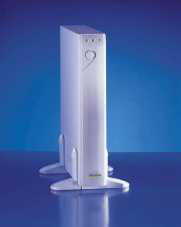
One of the many uses of Linux is creating thin clients to save time and money.

Manufacturer: IGEL LLC
E-Mail: sales@igelusa.com
Price: $480-$699 US
Reviewer: David Weis
One of the many uses of Linux is creating thin clients to save time and money. Products in the Etherminal line of thin clients are built with that in mind. They are available in a variety of configurations, including Java support, X support, text-based terminal emulation and Microsoft Windows terminal support.
An innovative feature of these products is the fact that the entire file system is stored in flash memory. This will eliminate problems with improper shutdowns and the short lifespan of spinning magnetic media in harsh environments.
I tested the Etherminal J and the Instant TC (thin client) products. The Etherminal J includes Netscape Communicator with Java support, the Citrix ICA client, an RDP client, an X server, terminal support and printer support. The Instant TC is a kit that includes these features, but comes on an 8-bit ISA card with an included S3 video adapter.
The Etherminal J is a turn-key unit that is 11-1/2 inches wide by 8-3/4 inches deep by 2 inches tall. It includes mounting feet to orient the unit vertically to save desk space. It's powered by a 180MHz Cyrix processor with 32MB of RAM, on-board 10/100 Ethernet, 16-bit sound, S3 Video, two serial ports, one parallel port and a PS/2 keyboard and mouse port. You need to supply the monitor, keyboard and mouse.
Installing the Instant TC into a machine is quite easy, consisting of installing the two cards and a supported network card: only ISA and PCI NE2000 cards and the Intel EtherExpress Pro.
Both products performed well in daily use. I used the Etherminal J as my desktop machine for two days in order to get a good feel for the performance.
A full version of Netscape was included with both products, and it was more stable than the same version on my normal machine. Once Netscape had loaded, it was very snappy and performed well.
The Etherminal included terminal emulation support for SCO-ANSI, Linux-ANSI, VT320, Wyse60 and SNI97801. The function keys worked correctly when connecting to Linux servers, in addition to an RS/6000 and an AS/400 to which I have access.
One use for the Etherminal is as an X terminal. You can easily set up XDMCP to connect as a client to a larger machine or run X applications remotely and have them appear on your local display. With a 100Mbit network, the response was as good as running them locally.
If you need access to Microsoft products, the Etherminal has the capability to connect to the Windows Terminal Server and the Citrix Metaframe Server. I don't have access to either of these, but the clients are the same ones available from Citrix, so I have no doubts as to their functionality.
One pleasant surprise was how nice the fonts looked on the Etherminal. They were nice, sharp 100dpi (dots per inch) fonts that were very easy on the eyes. Selecting fonts for your applications is made easy by the Igel Setup Program.
After starting either of the devices, you will arrive at an X desktop. From the menu on the screen, you can run the Setup Program which allows you to configure all aspects of the client software including the keyboard, language, network, serial ports, applications, time and date. Updating the firmware is also done using the Setup Program.
The Setup Program is one place where the amount of work put into this product is evident. Changing the setup is quite easy and intuitive. Selecting a screen resolution takes only two clicks. Adding remote applications to the menu is also easy. You need to choose whether the remote host will be accessed using a text emulation, a Windows Terminal emulation or via X. For text emulation, there are selections to specify window background and foreground colors, font size, cursor size and the size of the window in rows and columns.
Documentation included with the Etherminal consisted of a 92-page manual covering the Etherminal C, W and J in English and German and a 42-page manual for the actual hardware. The Etherminal manual contains detailed information on how to configure your Etherminal. The hardware reference manual covers BIOS setup. However, you shouldn't need to modify any of the BIOS parameters from their defaults.
In the course of my evaluation, I did find a few problems with the Etherminal. Flash memory is much slower than most hard drives. Netscape Communicator took over 60 seconds to load. A dialog box did appear after launching Netscape, to reassure you it was starting up. Closing and reopening Netscape got that time down to under five seconds, showing that it had been cached in memory.
Another point that isn't as obvious is that the flash memory driver used for the Linux kernel on the Etherminal isn't released under the GPL and is statically linked with the kernel. However, Igel was the original author of the wrapper to link the M-Systems driver with the kernel, and Igel has released the portion they wrote.
The Etherminal and Instant TC are both well-built and well-designed products. They are excellent replacements for dumb serial terminals, X terminals and older PCs. I have no problem recommending them.